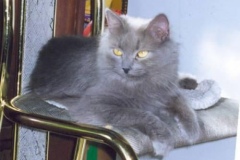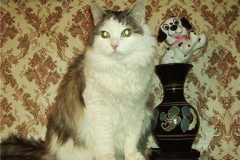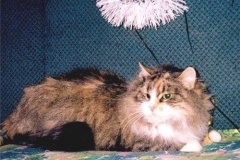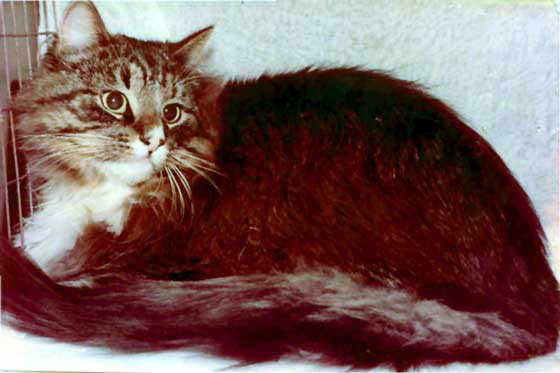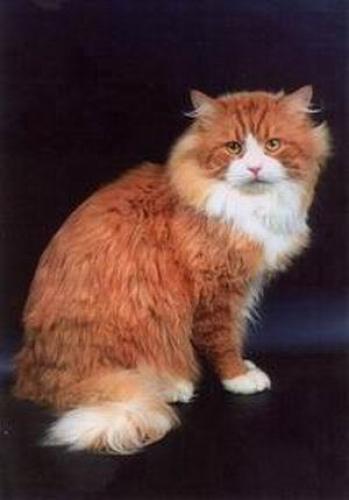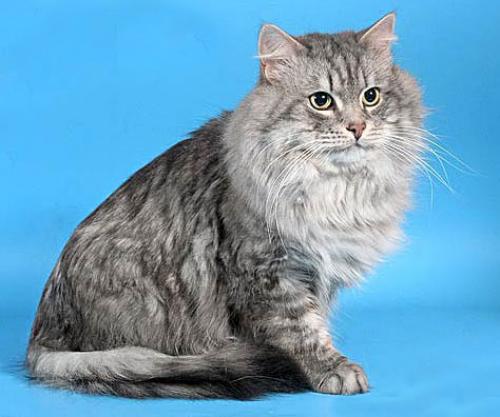Chingi Tura cattery was owned by Dina and Sergey Smirnova Lvovna from St.Petersburg.
Chingi Tura is a multi-owner collaboration work cattery, and Nikolaeva Ekaterina and Alekseeva Galina Shternovna are also part of the cattery.
Dina Smirnova also owned Lusha Chingi Tura, one of their foundation cats, born on 28/06/1990 and Chingy Tura Kitty born on 05/07/1990.
Kusai is a blue solid female foundation cat owned by Alekseeva Galina Shternovna. The cat had good show results (Ch. WCF) and was used exclusively in the Chigi Tura lines.
Ten years ago, I nearly purchased Asia Chingi Tura, but I gave up because even if she was very pretty, she was a Torbie, and I am not a great fan of Red Cats. However, I regret this decision because these lines complete the Moscow and Krasnoyarsk lines and are helpful for genetic diversity.
I finally purchased a cat from these lines, and it is a 0% match with most of my genealogies without sacrificing type with a complete ped. Here are some fantastic Chingi Tura cats.

Roman (SIB n 03 23, born 11/2/87) belonged to Ivanova Anna from St Petersburg.
Roman’s mother, Rysja (SIB n 03 23, born on 9/11/83), was simply a house cat registered as SIB who obtained excellent results in shows and became Gr.Int.Ch.(WCF).
His father was a foundation cat from the area, but there is no information about his father’s ownership.
Roman was registered at the Varieta Club in St. Petersburg.
He is one of the foundation cats for the Chingi Tura lines, and here are some of his offspring. You will also find Roman in nem peds, but I believe the cat wasn’t a CS carrier because I checked all his matches, and until now, I haven’t found nem directly from Roman.
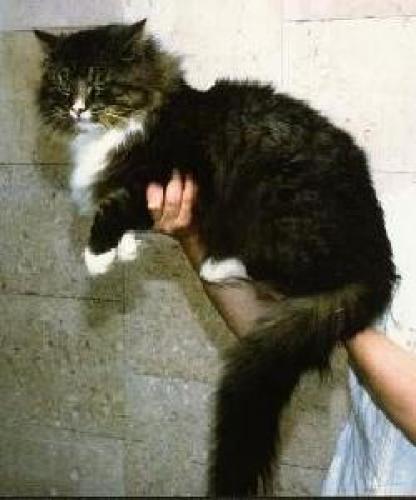
Betsi Chingi-Tura
Vergiliy
Motya
Zhura
Elona Chingi Tour
Waks-Rolas
Motjia
Zura
Bashena
Anfissa II
Aleks Romanovich of Starpoint
Ofelia Romanovna of Starpoint
Naina Romanovna of Starpoint
Melinda Romanovna of Starpoint
Oskar Kotofei
Anastasia Romanovna of Starpoint
Marcell’s cattery breeder was Galia Izmailova from St.Petersburg.
These lines were created using Chingy Tura cats and foundation cats from the area.
There was some rivalry between the St. Petersburg and Moscows lines, but Moscow Cats had a neat advance in work regarding consistency in type. These lines were bred apart for a long time, which is an advantage since it was possible to lower the inbreeding coefficient with these matches and bring diversity with full-ped cats.
All these cats nowadays are part of group 3, but they are essential.
As most readers know, there is no better or worse regarding groups, and the most important is genetic diversity, keeping the cats as close as possible as they used to be and outside of further “external influence”. I’m afraid the poorest group in diversity, and in terms of type, is group 1 (unless they are foundation cats, and I mean real, unrelated foundation cats who can actually bring high diversity matched with our full-ped Siberians).
I intend to develop this text further on Marcell’s lines, so this article isn’t finished yet, and there is more coming soon, but I wanted to get ahead on the work, post and leave some photos of Marcell’s Siberian cats.

